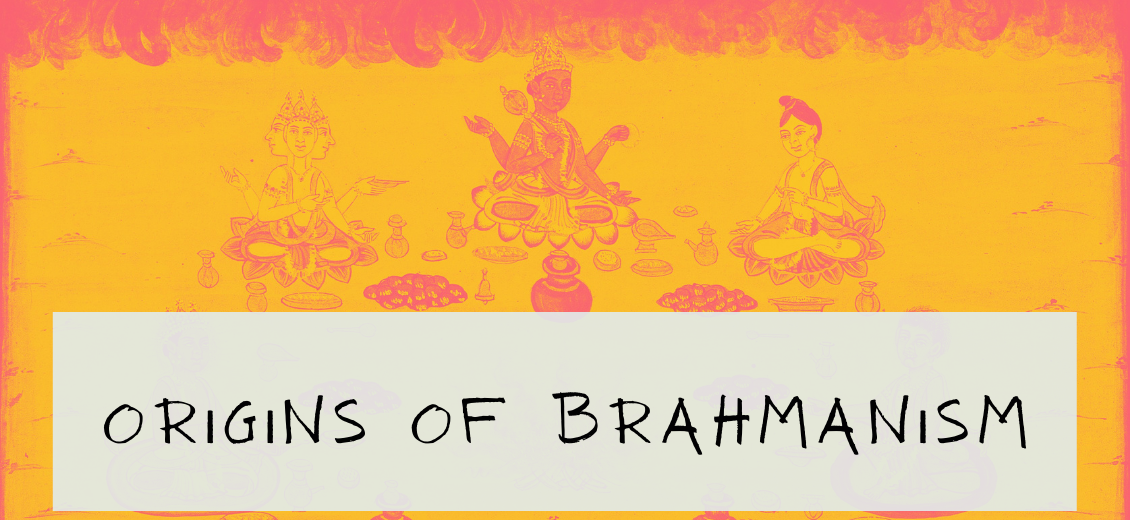Origins of Brahmanism
Blogs Home
- 27 Dec 2021

“Brahmanism is rather a philosophy than a religion.” — Sir Monier Williams
Introduction
Sir Monier Williams, describes Brahmanism as a spiritual doctrine that identifies God with the universe. Brahma is only a creator in the sense of being, the first evolution out of the one Spirit, the evolution from which all other evolutions have proceeded.
The Satapatha-brahmana (Sukla Yajurveda) states that:
Origin of Brahmanism
Scholars trace the origin of Brahmanism to Vedic times. It teaches the identification of all the forces and phenomena of Nature with one spiritual Being — ’the only real Entity’. The proponents of Brahmanism describe their religion as Arya-dharma (the religion of the Aryas; or Vaidika-dharma). It is interesting to trace the crystallization of the rudimentary doctrines of Brahmanism into a definite shape since the time of its origin.
In Vedic times people believed in one Supreme Being. The hymn composers expressed a man's curiosity to learn about the Infinite. They took to personifying the Sky, Sun, Fire, Air, Water, Earth. They bethought them with awe of this same ‘Spirit’ (atman) vivifying their bodies with the breath of life — of this mysterious presence enshrined in their conscience. Then they identified this same ‘Spirit’ with the divine creative impulse thrilling through the imaginations of their hymn-composers — with the spiritual efficacy of the hymns themselves, with the mystic power inherent in divine knowledge and prayer. This mysterious, all-pervading, vague spiritual Power and Presence, which was wholly unbound by limitations of personality and individuality, became a reality. This Breath of Life (Atman) received a name. They called it Brahman. It expanded itself through all space. The concept of ‘Brahman’ was that of a pure essence that not only diffused itself everywhere but constituted everything. Men, gods, and the visible world were merely its manifestations. Such was the fundamental doctrine of Brahmanism.
Tracing the journey of Brahmanism
Tracing the date and place of origin for Vedic thought is unknown, but two theories have been noted in history:
(1) The Indo-Aryan Migration theory: It suggests that the Vedic vision developed in Central Asia (around the region of the Kingdom of Mitanni, modern-day northern Iraq, Syria, and Turkey) and arrived in India during the decline of the Indus Valley Civilization (c. 7000 - c. 600 BCE) sometime between c. 2000-1500 BCE.
(2) The Out of India Theory (OIT): The OIT claims the Indus Valley Civilization (also known as the Harappan Civilization) developed the Vedic vision, exported it to Central Asia, and watched it return with the Indo-Aryan Migration. Several Gods' names – notably Indra – were known in Central Asia, and one of the most important concepts of Brahmanism — the cosmic order was also well established there. It is thought that, around the 3rd millennium BCE, a group of nomadic Aryan tribes migrated into Central Asia, and two of these, Indo-Iranians and Indo-Aryans, parted ways; The Indo-Iranians settled in the Iranian Plateau and the Indo-Aryans continued southwards to the Indian subcontinent. The term Aryan was understood as a class of people meaning "free" or "noble".
Phases of Brahmanism
Brahmanism is a complex system — a system which may be regarded as possessing four sides, or rather four phases running into each other and are separable by sharply defined lines, namely:
Ritualistic Brahmanism
This phase of the Brahmanical system has its own sacred treatises called “Brahmanas”, added to the Mantra or Hymn portion of each Veda.
For example:
- The Aitareya – the Rig Veda
- The Satapatha – the Yajur Veda
- The Tandya – the Sama Veda
- The Gopatha Brahmanas – the Atharva Veda
They are an integral part of the Vedas and are supposed to contain that portion of divine knowledge that is adapted to serve as a directory for the Brahmans in the conduct of the complicated sacrificial ceremonies.
It was deemed necessary in the early Vedic period to propitiate and maintain the energies of nature by means of invigorating offerings of food. It was unlikely that such offerings would be dispensed with when these same energies were personalized as divine manifestations of the one Spirit.
It is also evident that human sacrifice was once part of the Ritualistic Brahmanical system. However, the Brahmana records substituted the sacrifice with four kinds of animals — horses, oxen, sheep, and goats — for that of men.
Sometimes immense numbers of animals were tied to sacrificial posts (yupa), some were killed and some liberated at the end of the ceremony. One of the most noteworthy ideas to be found in the Brahmanas is that the gods were merely mortal till they conquered Death by sacrifices.
Philosophical Brahmanism
It is often described as a purely spiritual doctrine of a universally diffused essence (Brahma), divested of all ritualistic incrustations, and carried into lofty regions of transcendental speculation.
The Upanishads are the special compilations of this phase of Brahmanism. The aphorisms (sutras) of the three systems of philosophy with their three branches were founded on these writings i.e.:
- the Nyaya with Vaiseshika
- the Sankhya with Yoga
- the Vedanta with Mimansa
These are paths to liberating the spirit of man from the bondage of repeated bodily existence, and reuniting it with the Supreme Spirit like a river meets the ocean.
Most Philosophical Brahmanism thinkers agree that spirit or soul is eternal. The living spirit of man (jiva) — the human Self (Atman) — is identical with God's Spirit. That Spirit is limited and personalized by the power of Illusion and the life of every living spirit is nothing but a minute arc of one endless circle of infinite existence.
The spirit, so united, commences acting, and all actions, good or bad, lead to consequences, and these consequences must have their adequate rewards or punishments.
The so-called pantheistic theory of the Vedanta philosophy is attractive to the majority. It is true that the Sankhya and Vedanta together underlie Brahmanism, but the Vedanta is the more orthodox.
Vedanta:
- It is a belief in the non-duality and non-plurality of the Spirit i.e, in one eternal Spirit called Atman or Brahman instead of many; a belief in the identification of the human spirit and of all the phenomena of nature with that one Spirit when enveloped in illusion.
- It is a belief that a kind of threefold Trinity, three spiritual essences, three corporeal envelopes, and three dominating qualities — together constitute one personal God, as well as every human personality.
- The term Guna denotes the three Qualities as the constituents of Prakriti — Activity (Rajas), Goodness (Sattva), and Indifference (Tamas).
Mythological Brahmanism
The Mythological phase of Brahmanism has its own compilations. The two great legendary heroic poems (Itihasa) of this phase are the Mahabharata and Ramayana. Its development was probably synchronous with that of Buddhism.
The Brahmans in their popular teaching were simply carrying out their own doctrine of evolution. The only problem they had to solve was, “How could any theory of evolution be made to comprehend existing superstitions and be best applied to the development of a popular mythology.”
They observed that a series of higher forms of existence above the earth, such as demigods, supernatural beings, inferior gods, superior gods, is traceable upwards from man to the primeval male god Brahma. This male god Brahma stands at the head of creation as the first evolution and hence the apparent Evolver of all the inferior forms.
Polytheistic Gods
The incarnations of Vishnu
In this, it is believed that these descents (avatara) on earth were undertaken for preserving the world when in pressing emergencies like when its safety was imperiled by the malice of evil demons. Incarnations are of four kinds and degrees:
- the full descent, as in Krishna, one of the heroes of the Epic poem, Mahabharata.
- the partial descent, consisting of half the god's nature, as in Rama, hero of the other Epic, Ramayana.
- the quarter descent, as in Rama's brother Bharata.
- the eighth-part descent, as in Rama's two other brothers, Lakshmana and Shatrughna.
Brahma and Siva
- These two members of the Indian triad have no such human incarnations as those of Vishnu, though the god Brahma is humanized in his representatives, the priests, called Brahmans.
- It is true that certain incarnations of both Brahma and Siva are sometimes mentioned (as, for example, the form of Shiva and Veerabhadra), and there are local manifestations of these deities and local descents of Siva in human form.
- It may be noted that Siva has two sons, Ganesha and Subrahmanya (also called Skanda and Karttikeya), who are generals of the celestial armies, whereas Vishnu has no sons except in his human incarnations.
- Forms of Vishnu, Siva, and their consorts, with the two sons of Siva (Ganesha and Subrahmanya), and Hanuman are the chief temple deities of India. But there are an infinite number of divine and semi-divine beings, good and evil demons, every one of which is held in veneration or dread.
- Each one of these from the highest to the lowest, is, like all the others, subject to the universal law of re-absorption into the one divine universal Essence (Brahma).
Nomistic Brahmanism
It represents that period in Indian religious history when the Brahmans composed codes of law and laid down precise rules for the constitution of the social fabric, for the due coordination of its different orders, and for the regulation of everyday domestic life.
In religious and philosophical thought, it is the unbending rigidity of the rules and ordinances by which every act of a man's social and domestic life is fettered and controlled. These rules are contained in three principal codes.
The three principal codes:
- Code of Manu: It was originally a mere local code, embodying rules and precepts — perhaps by different authors, some of whom may have lived in the fifth century BC, or even earlier.
- Code of Yajnavalkya: It introduces many additional rules, some of which are probably as late as the first or second century of our era. It is always associated with its commentary, the Mitakshara.
- Code of Parasara: It enacts special laws adapted to the fourth or most depraved age of the world (called Kali).
The three chief codes are mirrors of Indian domestic manners. They illustrate very strikingly the close intertwining of law, politics, and social life with religion and religious ordinances.
The doctrine of Manu was that the deity created distinct kinds of men, as he created varieties of animals and plants; and that Brahmans, soldiers (Kshatriyas), agriculturists (Vaisyas), and servants (Sudras) were born and must remain from birth to death distinct from each other.
Conclusion
Brahmanism is the belief system that developed from the Vedas during the late Vedic Period, originating in the Indus Valley Civilization after the Indo-Aryan Migration. The origin of Brahmanism has been a contradictory subject. Its interpretation over time has portrayed a different point of view in philosophy. Tracing the origin of Brahmanism, it can be observed that it had a sacred meaning i.e. a spiritual doctrine that identifies God with the universe (universal entity). But as time ticks by, it can be scrutinized that its interpretation transitioned from ritualistic Brahmanism to Nomistic Brahmanism which has totally changed its original outlook.
What started out as a belief system, a way of living has turned into a religion over time. Brahminism, as we have understood above, was brought into existence to help humans identify all the forces and phenomena of Nature with the one spiritual Being, which has now become a full-fledged religion. All religions came into being to solve some pressing societal problems, and this also applied to Brahmanism. Thus, Brahmanism answered the questions regarding the origin of the universe and found an individual’s place in it.

Riya
Sources:
Brahmanism and Hinduism by Sir Monier Monier-Williams
https://www.bhagavadgitausa.com/BrahmanismAndHinduismByMonier-Williams.pdf
The Historiography of Brahmanism by Johannes Bronkhorst
https://serval.unil.ch/resource/serval:BIB_AA40C6D8734D.P001/REF
Blogs Home



